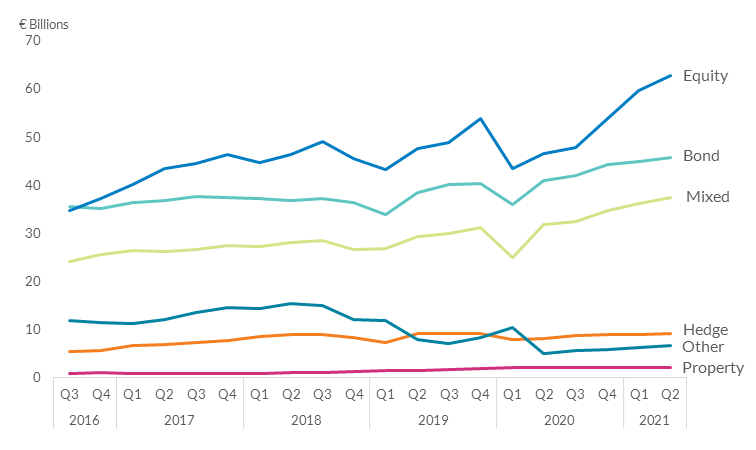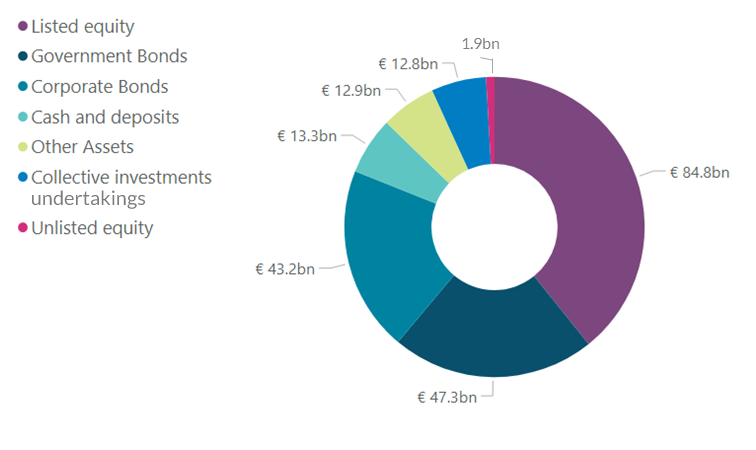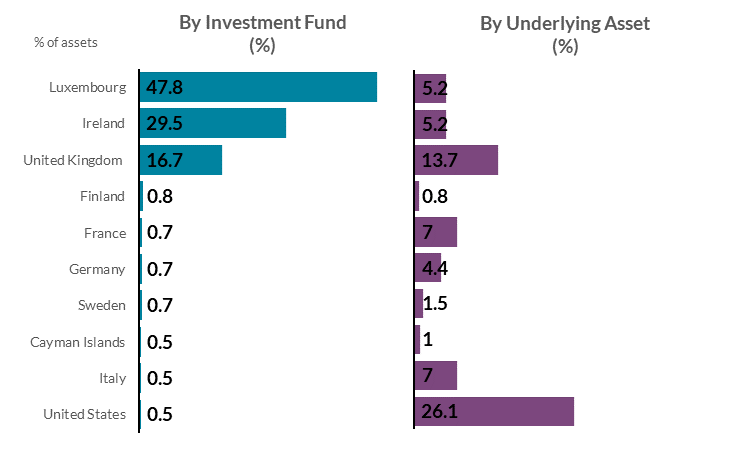Behind the Data

Through the looking glass: understanding the inter-connectedness of the Irish insurance sector and investment funds
Authors Luke Kent and Róisín Flaherty*
January 2022
New data provides initial insights on the underlying financial exposures of insurance corporations and their policy-holders from investments in funds. The majority of underlying equities are issued in the US while underlying sovereign bonds are predominantly issued in the Euro Area.
The insurance sector is a key provider of long-term saving and investment products in the Irish economy, especially popular among households and pension funds. The dominant products are structured as unit-linked policies, where investment decisions and risks predominately sit with policyholders rather than the insurer. Understanding the insurance sector’s investment portfolio is an important step towards monitoring the exposures and economic decisions of both the insurer and customers. Statistical frameworks have traditionally focused on the first counterparty in any investment decision. However, this may present a narrow picture of the underlying risks and portfolio investment behaviours, in particular when an intermediary such as an investment fund is used by the insurer. In such instances, the first counterparty position masks the underlying pool of financial assets.
Investment fund shares are the dominant financial asset held by Irish insurers. Irish insurance companies hold €164 billion investment fund shares (excluding money market funds), accounting for 40 per cent of the insurance sector’s assets at end-June 2021. While potentially diversifying risk, by holding investment fund shares, insurers also indirectly increase their exposure to a large array of markets, industries and geographical locations. Schmitz and Carvalho (2021) show that the interlinkages between the euro area investment fund and insurance sector has increased in recent years with the use of investment funds growing at a faster rate than other sectors. As such, a full look-through into the investment fund assets is required to fully understand the investment activity.
New data presented in this Behind the Data provides initial insights into the underlying assets of investment funds linked with insurance corporations, exploring the underlying risks to both insurers and their investment customers. In exploring these risks, the geographical location and asset category of these underlying assets are highlighted.

The Data
This Behind the Data uses granular data submitted by insurance companies under Solvency II and ECB Statistical Regulations since 2016 (see Kelly and Osborne-Kinch (2018)), to provide a full look through into the underlying assets of investments made through investment funds. We focus on the distribution of these assets by geographical location and asset category. The location of the entity issuing the underlying assets often differs significantly from the country of residence of these funds (i.e. the country in which the fund is legally authorised). These granular “look through” data are at a quarterly frequency and cover insurance and reinsurance companies resident in Ireland.
The rise of investment funds
Consistent with the findings by Schmitz and Carvalho (2021), Irish insurance companies holdings of investment fund shares increased by 46 per cent since September 2016. This includes a period of pronounced price fluctuations caused by the economic effects of COVID-19 (Chart 1). Irish insurers primarily hold shares in equity, bond and mixed funds with hedge, property and other specialised funds accounting for relatively small exposures. The nature of the risk can differ across these fund types, with equity funds exposed to the volatility of equity markets (ECB, 2014) and bond funds more susceptible to liquidity mismatch (Cima, Killeen and Madouros (2019)). Other sources of risk such as leverage can vary across fund type and strategy, with real estate, “other funds” and hedge funds most likely to have leverage (Central Bank of Ireland, 2021)
Chart 1 - Holdings of Investment Funds by Insurance Companies (by fund type)

Source: Central Bank of Ireland; Insurance Corporations Statistics; Q2 2021
Looking through to the underlying asset class of IFs
While the fund type provides a high-level description of the broad underlying assets, more granular data is needed to accurately understand the composition of the exposures. For example, under the current reporting methodology, if an investment fund holds above 70 per cent of its assets in a given investment category (e.g. equities), then this investment fund is classified as that type of fund for reporting purposes. As such, the headline categorisation may disguise significant non-core investment activity that a look-through would otherwise reveal.
Using the look through approach, the most common categories of underlying assets are equities, government bonds and corporate bonds (Chart 2). Differences are evident when compared with the headline fund type breakdown above. Bond funds account for 28 per cent of the fund holdings held by insurance companies, but using the full look-through, it is possible to see that bond instruments account for 42 per cent of underlying assets. Similarly, while equity funds account for 38 per cent of fund investment, equity instruments account for 40 per cent of underlying assets, a difference of €24 billion.
Chart 2 - Asset Categories of Underlying IF Assets

Source: Central Bank of Ireland; Insurance Corporations Statistics; Q2 2021
Note: Collective investment undertakings (CIUs) refer to funds-of-funds in the case of CIUs as underlying assets within IF shares. “Other Assets” here equated to 6% of all assets and comprises of Futures, Properties, Collateralised securities, Mortgages and Loans, Forwards, Structured Notes, Credit Derivatives, Call Options, Put Options, Swaps and Other Investments
An additional advantage of the look-through approach over the traditional statistical first counterparty focus, is a more accurate picture of the geographic exposures. This is particularly important for assets such as investments funds where residency is concentrated in a relatively small number of countries such as Ireland or Luxembourg partly due to specific legal frameworks (OECD, 2019). The underlying assets location is a closer reflection of the geographic risks and/or diversification of the fund. Chart 3 shows the top ten countries of residence of investment funds held by Irish insurance companies as would be visible in traditional first counterparty assessment. The picture changes significantly when the focus adjusts to country of the underlying asset. The differences between these accentuates the value of the look-through approach. For example, almost half of the investment fund shares held by Irish insurers are domiciled in Luxembourg, however, just over 5 per cent of underlying assets are issued in Luxembourg. Similarly, the financial linkage with Ireland declines from €53 billion to just €11 billion when the look-through approach is used.
Chart 3 - Changing geographical exposures using look-through approach

Source: Central Bank of Ireland; Insurance Corporations Statistics; Q2 2021
Location of underlying assets differs by instrument type
Using the look-through data, we find that the majority of the equities have been issued in the United States (Chart 4). Similarly, we see government bonds held by insurance companies via funds are predominantly issued by euro area countries (Chart 5). The €47 billion of these government bonds held indirectly by insurance companies far exceeds the €30 billion of government bonds held directly by insurers. Additionally, the €85 billion of listed equity held via investment funds is considerably greater than the €52 billion direct holdings of listed equity. Such considerable differences highlight the value of the additional granular data developed to support statistical and supervisory assessment in recent years, as it offers a far more transparent picture of the underlying exposures of insurance companies and their customers.
Chart 4 - Issuers of listed equities held by Irish ICs through IFs (as of June 2021)
.png?sfvrsn=d50a931d_2)
Source: Central Bank of Ireland Data; Q2 2021
Chart 5 - Location of government bonds held by Irish ICs through IFs

Source: Central Bank of Ireland Data; Q2 2021
Conclusion
This Behind the Data introduces look-through data providing new insights on the underlying investment exposures of insurance companies and holders of insurance investment products. As the underlying financial asset values underpin the return on these products, any risk and reward to these assets through financial market movements may flow through to policyholders. The growing use of investment funds in Ireland and Europe increases the financial interconnectedness between the sectors, and with the ultimate holder of the risk in insurance investment products.
The look through analysis provides a breakdown of the underlying assets by instrument type and geography, revealing significant differences between the traditional first counterparty presentation in official statistics, and the underlying asset locations. The prevalence of companies based in the United States in underlying equity assets is evident, with Euro Area member states the main issuers of underlying government bonds. These initial insights illustrate the complexity of the far-reaching indirect exposures to Irish ICs through their IF share holdings.
As investment funds continue to be a key component of insurance companies’ investment management, future analysis can use these insights as a foundation for a more detailed focus on the underlying assets within these funds, including an investigation of the issuer sector of these assets.
*Email [email protected] if you have any comments or questions on this note. Comments from Kenneth Devine, Jenny Osborne-Kinch, Rory McElligott, Maria Woods, Eoin Haugh, Peter Towers, Faheem Mirza, Mark Cassidy and Sharon Donnery are gratefully acknowledged. The views expressed in this note are those of the authors and do not necessarily reflect the views of the Central Bank of Ireland or the ESCB.